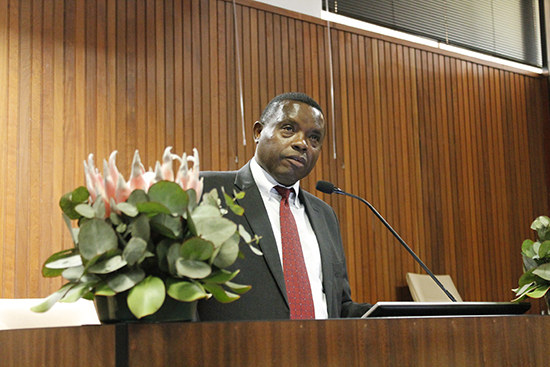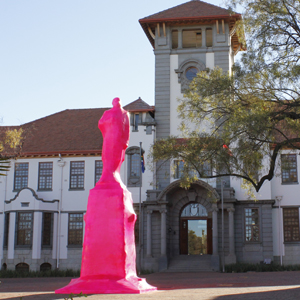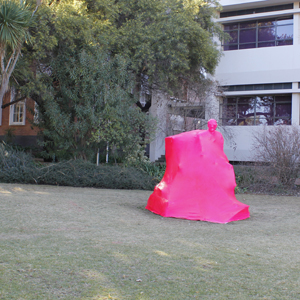Latest News Archive
Please select Category, Year, and then Month to display items
19 November 2018
|
Story Charlene Stanley
|
Photo Charlene Stanley
 Prof John Mubangizi, Dean of the Faculty of Law, encouraged delegates at the Fifth Annual International Mercantile Conference to share ideas on best international practice in their various fields.
Prof John Mubangizi, Dean of the Faculty of Law, encouraged delegates at the Fifth Annual International Mercantile Conference to share ideas on best international practice in their various fields.
“Don’t say anything online that you wouldn’t want plastered on a billboard with your face on it.”
This famous quote by international tech expert Erin Bury should be a guiding light when it comes to online habits in the workplace, according to Francois Cilliers, UFS Lecturer in Mercantile Law.
In his presentation Could Social Media be the Gateway to Employment Discrimination? he warned that employees have a responsibility not to bring their employers in disrepute through their comments on social media.
“Posts, updates, tweets, and comments are considered to be publications and can therefore never be seen as privileged information,” he explained.
Responsibility on employees and employers alike
He pointed out that employers also had a responsibility regarding the way in which they use the information about prospective employees obtained via social media.
“Nowadays, approximately 75% of companies hire through social media. In the US, recruiting companies spend hours researching candidates, making full use of what they can find on social media. It was found that 50–80% of employers frowned upon posts and pictures featuring drug and alcohol abuse, profanity, and bad grammar.”
He warned that employers needed to tread lightly, as a decision not to employ someone as a result of information on the prospective employee’s political views and sexual orientation could constitute unfair discrimination as set out in the Employment Equity Act.
“An employer who wishes to use a screening process (utilising social media) has to prove that the information and the process is objectively necessary and can be justified with reference to the inherent requirements of the job,” he explained.
“As technology and electronic systems advance, so too should the applicable labour laws.”
Cilliers’ presentation formed part of the Fifth Annual International Mercantile Law Conference recently hosted by the Faculty of Law on the Bloemfontein Campus.
Incorporating new technology in teaching and research
“This conference is an opportunity to share ideas on best practice in what is perceived as a ‘difficult’ field within Law,” said Prof John Mubangizi, Dean of the Faculty of Law, as he opened the proceedings. Topics in the discussion sessions ranged from Racism in the workplace and The underrepresentation of females in the judiciary, to Decriminalisation of cannabis: A recipe for healthy employer-employee relations?
“Conferences such as these help us to take advantage of the newest developments in technology to advance our teaching and research,” said Prof Mubangizi.
“To quote Einstein: ‘We can’t solve problems by using the same kind of thinking we used when we created them.’”
Pres Steyn turns pink in anticipation of Vryfees
2014-06-06
Video clipLive streaming  |
Australian artist Cigdem Aydemir vacuum packed the Pres Steyn monument on the Bloemfontein Campus’s Red Plain – in pink. Aydemir’s project, ‘Plastic Histories’, forms part of a public art project that encourages us to evaluate public monuments in their historical context.
By vacuum packing monuments, Aydemir alludes to their significance and preservation. At the same time, though, it reveals the nature of their contentious and gendered historical function. This is because most monuments in post-colonial countries typically celebrate men’s achievements in serving their nations.
In response, this project acknowledges the contribution of women from all races, communities and sexual orientations to the grand narrative of a post-apartheid South Africa.
Aydemir is also developing an app in collaboration with Australian artist Warren Armstrong. This will be used for augmented reality viewing of three city monuments – those of President Brand, General De Wet and General Hertzog. This means that visitors will be able to hold a smart phone or iPad in front of the monuments and view the monuments as if vacuum packed in pink plastic.
In conjunction with the public art project there will be an exhibition of digitally manipulated photographs of nineteen-century and contemporary male monuments in Bloemfontein. These photos will be exhibited at the Johannes Stegmann Gallery at the UFS Sasol Library from 15 July – 1 August 2014.
Public tours on the Bloemfontein Campus and into the city will take place on:
• Tuesday 15 July at 11:00,
• Wednesday 16 July at 14:00, and
• Saturday 19 July at 11:00.
 |
Aydemir’s ‘Plastic Histories’ public art project is part of the UFS Programme for Innovation in Artform Development (PIAD) and the Vryfees arts festival’s partnership with the Australian-based SituateArt in Festivals initiative. This partnership is managed by the Salamanca Arts Centre in Tasmania.
Read more articles about this project:
POZIBLE launch (pdf document)
Media release: 17 June 2014: Art Stars Revealed (pdf document)
PIAD/PIKO - http://bit.ly/1gazQTV
OPENLab - http://bit.ly/1hzguUG
CAD Forum - http://bit.ly/1sNvtRB